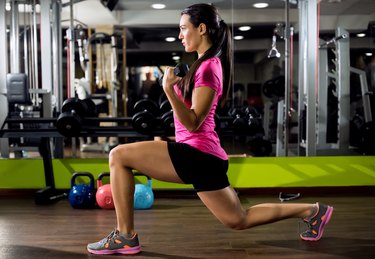
Let's cut to the chase. You can't determine exactly where fat gets deposited in your body. Once you digest your food and the glucose hits your bloodstream, your pancreas releases hormones that transform the glucose into carbs and fat, which then get distributed throughout your body. How many excess calories you eat determines how much gets stored. Your genes determine where the fat gets stored, says Dr. Barry Starr, of the Stanford University School of Medicine. So, if you're looking to increase the size of your hips, you must build muscles in your hip region to provide bulk, while maintaining a layer of subcutaneous fat.
Mind Work
Video of the Day
Step 1
Determine your body type. If you tend to gain weight in your hips and butt, you have a pear body type. If you tend to gain weight in your belly, you have an apple body type. If you have the pear body type, storing fat in your hips will be a breeze. Simply eat more. However, since you're reading this article, chances are good that you have the apple type body. Eating more will add more fat to your belly than to your hips.
Video of the Day
Step 2
Accept that though you can enhance your shape, there are limits. Your bone structure determines the width of your hips and your genetic body type – apple versus pear shaped – determines whether excess calories get stored in your hips, belly or elsewhere.
Step 3
Commit yourself to a routine of daily workouts. You can't target your hips to add fat, but you absolutely can target and build muscles in your butt and hips. To build a bigger butt and hips, commit to resistance training. Join a health club or get some weights. To start, commit to doing two or three sets of three exercises per day, performing eight to 12 repetitions of each exercise in each set.
Step 4
Monitor your weight and manage your calories carefully. As you burn more calories working out, you may need to alter your dietary habits: Increase your calories and especially your protein intake to maintain your muscle mass and retain smooth curves in your hips and butt.
Body Work
Step 1
Do squats. Stand straight up, then lower your body, bending at the knees, until you are just about in a sitting position. Return to the upright position. Add resistance by holding a bar across your shoulders or dumbbells in your hands. Vary the width of your stance to focus on different muscles. When you spread your feet wider apart, you'll work your hip and butt more.
Step 2
Do lunges. Stand upright, holding dumbbells at your sides. Step forward about 2 feet with your right foot, leaving your left foot in place. Lower your body as you lunge forward, but keep your torso upright. Don't put your knee forward beyond your toes. Use the heel of your right foot to push yourself to the upright position. Repeat the movement, stepping forward with your left foot.
Step 3
Do glute kickbacks. Kneel on all fours. In a controlled way, throw your right leg back, kicking the bottom of your foot upward toward the ceiling. Extend your leg upward, holding it for a count of one. Do 10 reps, then do the same with your left leg.
Step 4
Do walking lunges. Use the lunge motions to move forward, but instead of pushing back to the upright position after you lunge forward, instead, lunge forward with your other foot. Lunge across the room.
Step 5
Do deadlifts. Stand with your feet hip-width apart. Hold dumbbells in front of your thighs. Keeping your back straight, bend forward from the hips until the weights reach your shins. Squeeze your butt and raise yourself back to the upright position.
Things You'll Need
Bar
Dumbbells
Tip
Beef up your routine. Do 30 minutes of climbing on the Stairmaster, going at a slow, steady clip. Carry your weight on your feet and not on the handrails.